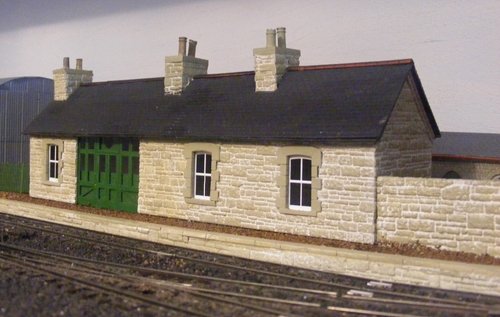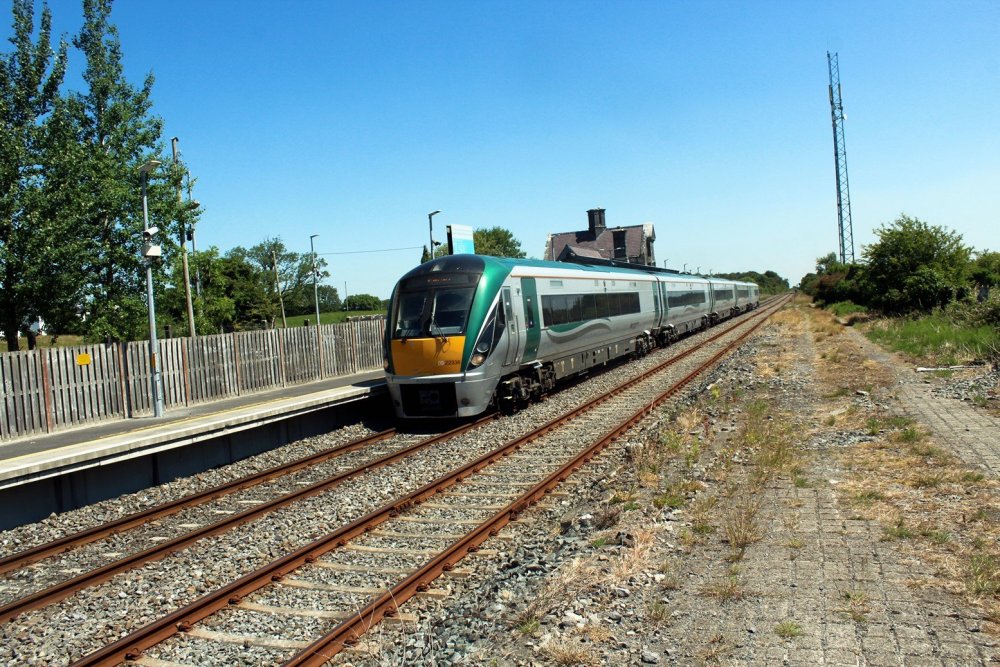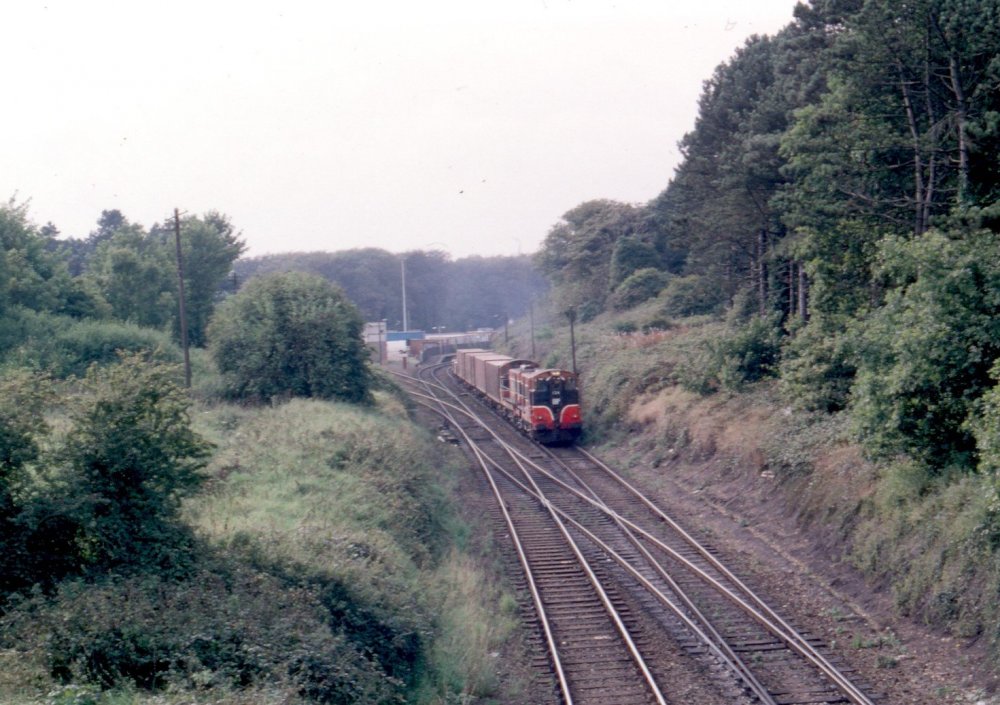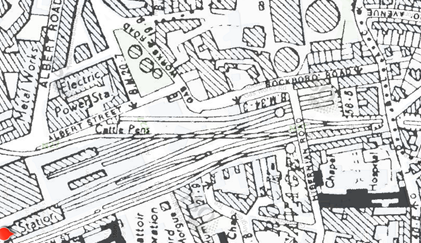-
Posts
4,729 -
Joined
-
Last visited
-
Days Won
117
Content Type
Profiles
Forums
Resource Library
Events
Gallery
Blogs
Store
Community Map
Everything posted by Mayner
-
B130 looks like Attymon Junction westbound B?? possibly Athenry Up platform Eastbound. I love the TPO!!!
-
It looks like a signal man would have had to stand beside the running line at track level to exchange a staff at the North Cabin and potentially risk serious injury, so far safer to exchange the staff on the platform and speak to another person. CIE sometimes provided a small platform at the cabin where a manual staff exchange could not take place at a station platform. Interesting to see a large ETS staff in use on a busy main line at such a late date.
-

North Down MRS Exhibition and Fair 13/14 April 2019.
Mayner replied to steventrain's topic in What's On?
A GNR 4w van makes sense and fits in with Leslie interests. The ventilate Y vans were built for bread and possible fish traffic, the late Harry Connaughton a professional modeler built a batch of these vans in O gauge during the 1970s might be worth watching out for. -

North Down MRS Exhibition and Fair 13/14 April 2019.
Mayner replied to steventrain's topic in What's On?
Leslie dropped a not so little hint that the loco was built in Belfast Any information on the new "passenger carrying vehicle kit"? -
Very impressive shed Tony, certainly a center piece for a diorama in its own right. I have used the Wills stone sheets for smaller buildings and generally brush paint the building in a dilute light grey to pick out the mortar joints and then paint the stone work with a dry brush technique. Paint is Testors solvent based Floquil which is unfortunately no longer available
-
I have my doubts about the Dublin Wicklow and Wexford using brake 3rd coaches as guards vans on loose coupled main line goods trains on its steeply graded main line. Braking heavy loose coupled goods trains was considered to be quite severe on ordinary coaching, this was less of an issue on narrow gauge lines that used passenger brakes with fully braked stock like the Tralee & Dingle, Donegal & Swilly. Many pre-amalgamation "goods brake vans" either tended to be a goods van with a brake compartment or a drovers coach with a brake compartment( The SLNCR van 2 included brake, drovers and goods compartments) rather than the classical goods brake van like the GSWR 10-12T brake van which evolved into the standard CIE 20 & 30T brake vans. It might be worth checking with the Historical Model Railway Association in the UK or transport museums in the Midlands and North of Englind, small to medium sized railways like the DWW tender to buy their goods stock off the peg from builders like Metropolitan Carriage and Wagon, Pickering or Cambrian rather than build their stock in house like the GSWR or Midland
-

North Down MRS Exhibition and Fair 13/14 April 2019.
Mayner replied to steventrain's topic in What's On?
The suspense is killing me, though I can't see Leslie bringing outs something so-post modern image as a 22XX though I like them The late Jim Beale exhibited a Minories style British Rail layout during the 1990s operated almost entirely by 1st & 2nd Generation DMUs, being a double track city terminus with 3 platforms the layout was quite challenging to operate just like a mini-Limerick or Heuston. -
Hi Patrick The GSWR birdcage brake 3rd really came up well, I especially like your pattern making with the springs and interior "module". I still have not gotten round to finishing the interiors and lettering on my pair of GSWR 6wheel coaches. It may be possible to have the springs cast in brass from your patterns. Some precious metal fabricators/casters use a cold casting technique in the 1st stage of in the lost wax casting technique https://morrisandwatson.com/ I used Morris & Watson an Auckland firm to produce brass castings from my own patterns, there are likely to be similar businesses in the jewelery manufacturing areas of the UK.
-

Ernies Massive Irish 1930's to 2005 Photo Archive
Mayner replied to Glenderg's topic in Photos & Videos of the Prototype
I spent a very enjoyable day driving from Stirling to Dublin (via Larne!) in September 1993 visiting Whitehead, Dundalk, Dunleer and Drogheda on the way. Freight traffic was a lot heavier on the Great Northern Line then two South bound Liners were recessed o in the up yard at Dundalk Junction presumably awaiting Customs clearance, I later saw the afternoon Dundalk-North Wall Liner passing Drogheda behind a pair of 121s presumably with cigarettes and beer from Dundalk! Only had a SLR with limited capability at the time so picture quality was not great A lot has changed in the last 25-6 years! -
Power at rail and maximum tractive effort (TE) are separate functions. Tractive effort is about pulling power and was measured in lbs. Horse power about how fast you can accelerate a train to the required line speed The 2,790 hp power at rail for the 201 Class is the power available for traction after taking out the power absorbed by the auxiliaries (compressor, cooling fan, generator, traction motors and mechanical losses. Republic Loco quotes 80% efficiency for locos with AC traction 70% for older DC units TE for diesels and steam is calculated differently. Diesel: The relationship between power and tractive effort was expressed by Hay (1978) as {\displaystyle TE={\frac {375*P*e}{V}}} [11] where TE is tractive effort, in pounds-force (lbf) P is the power in horsepower (hp) e is the efficiency, with a suggested value of 0.82 to account for losses between the motor and the rail, as well as power diverted to auxiliary systems such as lighting V is the speed in miles per hour (mph) Steam its a function of boiler pressure, wheel diameter and cylinder bore D and stroke! Tractive effort (TE) (or "tractive force") is in principal determined by boiler pressure, cylinder proportions, and size of driving wheels: TE = D² * S * const * p / d with D = cylinder diameter, S = piston stroke, p = boiler pressure, and d = driving wheel diameter. ("const" being a heuristic constant in the range 0.75 ... 0.85, depending on speed.) http://www.republiclocomotive.com/locomotive-power-calculations.html
-

Ernies Massive Irish 1930's to 2005 Photo Archive
Mayner replied to Glenderg's topic in Photos & Videos of the Prototype
The 6 wheelers unlikely to be at Grand Canal Dock, more likely to be Albert Quay looking across the yard towards the Hibernia Road bridge. I don't think the operating people at Westland Row would have tolerated a rake of redundant coaches cluttering up their carriage sidings and relief road between a very busy cramped station and the loco depot. Grand Canal Street Shed and Dock Mills would have obstructed the view of the gasworks from the carriage sidings, Tim Cramer in his "Irish Miscellany" series in Model Railway magazine in the late 70s spoke about "a little group of them spending their final years in Rocksavage Yard before being confined to the bonfires of progress: The coaches including a relatively modern (1910) MGWR 5 compartment lavatory 3rd together with older GSWR stock. Photo possibly taken across the running roads towards the goods yard between the end of the platform and signal cabin. Albert Quay was retained as a goods yard served by a connection from the Cork City Railway into the late 1970s interestingly while CIE lifted the running roads into the former passenger station the points were left in place. Albert Quay was retained as a goods yard served by a connection from the Cork City Railway into the late 1970s interestingly while CIE lifted the running roads into the former passenger station the points were left in place. http://eiretrains.com/Photo_Gallery/Railway Stations A/Albert Quay/IrishRailwayStations.html#AlbertQuay_20110505_003_CC_JA.jpg -
Funnily enough EU don't seem to have been impressed with Greencore decision to close the plant. https://www.irishtimes.com/news/sugar-factory-closure-needless-1.867073 Potentially looks like the closure was driven more by a windfall of EU compensation and potential profit from selling the site at the height of the property boom, than a EU poilicy decision.
-
Sugar beet was literally washed out of trucks and railway wagons using a water canon at the factories. May be some clips of beet being unloaded in the RTE archive, used to be on the 9 0 Clock news nearly every year in the 70s & 80s. The water canon/jets were mounted on a steel structure in the unloading area, at Mallow in its final years trucks were unloaded during the day and trains at night
-
Just received the February 2019 Journal. Front piece of a a pair of J15s on a Punchestown on an 8 bogie race special at Naas in 1956. Interesting articles on a diverse range of subjects including Waterford as a Railway Center and a photo feature on Private Sidings on Irish Railways. Plenty of photos of modelling interest and potential mini layout ideas in both the Waterford article and photo feature. Including: Photo from the railside of Bellferry at Frank Cassin Wharf terminal. B189 shunting a mixed train of 40' Freightliner containers & H vans at the Fry Cadbury siding near Rathmore. Traffic seems to have been heavy before the siding closed with the plant was served by two trip workings daily from Mallow. B160 shunting a modern looking bitumen tank wagon at Abbey Siding Cahir during the late 1970s. The wagon appears to be based on an ESSO Class A tank wagon imported from the UK in the late 1960s rather than an earlier CIE or Charles Roberts built tar tank wagon. B169 and train collecting an empty tar tank wagon from the Kerry County Council Lixnaw siding in 1963. B163 appears to have run forward from Lixnaw with her train and is preparing to haul the tank wagon back to the station, before re-marshalling the train and continuing on her journey
- 1 reply
-
- 1
-

-
Nice photo most likely in GSWR days almost looks like a fine scale model, possibly a "colourised" black and white photo. Station looks like a weatherboard version of Rosslare Strand and other stations on the Rosslare Route. I don't buy the Cuban analogy, the GSR & CIE continued to invest it physical plant and freight rolling stock up to date between the 1920s & early 1980s. Most of IEs current freight rolling stock is at least 30-40 years old, while the standard open wagons in the Castlecomer photo are of a new design at the time 4-5 years old.
-
Entirely appropriate for the 1st and possibly last trains on the Achill Branch or the afternoon "Perishable" from Rosses Point to Sligo. The Alphagraphix kit is a model of MGWR Mortuary Vans 42 & 58. The GSR re-numbered the vans 56M & 58M and ran them as fish vans. 56m (van in photo?) appears to have ended her days most likely as a luggage(pram?) van on the Waterford & Tramore. (Carriage Stock of the MGWR) IRRS paper Padraig O'Cuimin 1972?
-
Common on the majority of CIE 1950s 10' wheel base built freight stock, possibly more noticeable on wagons in the newer light grey compared to the old dark grey paint finished used up to the mid-late 1950s Most likely track dirt (mainly steel dust and mud) thrown up by the wheels in damp/wet weather.
-
Probably pretty much what it looked like in its last years before the departure of the afternoon passenger and the arrival of the C Class on the goods from Drimoleague. Ballasting the track has made a real difference, reducing the narrow gauge appearance and capturing that light flatbottom look so noticeable in photos of the West Cork stations and yards
-
I read some interesting behind the scenes material in a NZ railway magazine article when the local station was often a town or districts link with the outside world. The station's goods clerk would phone local businesses and customers to advise that their wagon had arrived and was ready for unloading or their consignment ready for collection from the good shed or out for delivery with road services. The traditional common-carrier railway provided a much more personalised level of service than today's logistic and railfreight businesses. Some American short line and Regional railroads still provide a similar level of services with local sales reps and offices rather than shippers having to go through an anonymous Call Centre 3000 miles from the customers business to order a freight car set out or pick up.
-
It could got very interesting if the Bawnboy Road-Maguires Bridge section of the Ulster and Connaught had been built with a Baronial Guarantee similar to the C&L and CVR. Under the guarantee railway shareholders were guaranteed a 5% return on capital in perpetuity secured by the Government & ratepayers in the area served by the railway. In the Free State the government basically bought out the Baronial Shareholding held by the GSR, in Northern Ireland CVR shareholders continued to receive their 5% dividend until Stormont bought out their shareholding allowing the line to close in 1941. Its just about possible that the section of line linking the C&L & CVR survived partition with its capital guaranteed by the Free State and Northern Ireland Governments, like the SLNCR Stormont would have had to compensate the Ulster & Connaght for loss of income arising from partition.
-
Using rail would fit in with Boliden's Sustainability Commitments & to keep within its existing carbon limits under the EU Emission Trading Scheme, and likely to continue until the existing wagons and loading/unloading infrastructure require replacement.
-
In terms of simplicity, scenic interest and varieties of rolling stock Carrignagat Junction-Sligo takes some beating, double track main line, Ballysodare Station compact layout with an interesting private siding (branch line) to Pollexfen's mill, WLWR(GSWR),MGWR & SLNCR trains, add in McAndrew's Sligo & Arigna if it got built operated with cast-offs locos and stock like the Athenry & Tuam & Ennis and Athenry. Interesting rock cuttings, nearby railway viaduct and interesting mountain backdrop. Nothing to report in terms of layout or rolling stock building, though the baseboard framing should be well seasoned before I start to lay the road bed and tracklaying. I have most of the softwood framing in stock for over 10 years and haven't got around to laying track
-
Seriously nice. Popeye!!!!!!!!!!!!!
-
It looks like Boliden are planning to extend the life of the mine beyond 2026. https://www.thetimes.co.uk/article/tara-digs-deeper-underground-to-secure-the-future-of-europes-biggest-zinc-mine-jztbzf6g5. It will be interesting if Boliden invests in a fleet of new wagons or manages to keep the existing fleet in service up to 2036.
-
There seems to be scope for quite interesting operation whether you operate end to end or eventually manage to build a continuous run though 3 road staging/fiddle yard could be quite limiting. The line seems to have been at its busiest between the mid-late 50s & early 70s when goods/freight traffic over the Limerick-Athenry line was heavier than the western end of the Dublin-Galway line. 2-3 scheduled goods trains + overloads, seasonal beet and cattle specials. It might be worth trying JMRI Operations http://jmri.org/help/en/package/jmri/jmrit/operations/Operations.shtml for wagon routing. Passenger wise there was a loco hauled Limerick-Galway mail train operated daily up to 1963 (A Class hauled in later years), 3 car AEC railcar sets on the Limerick-Sligo passenger trains often with cattle wagons and vans as tail traffic, small GMs & a couple of coaches after the Sligo trains were diverted to run to & from Ballina. Are you looking at modelling the embankment and underbridge at the Limerick end of the station? it adds to the visual interest.
.png.c363cdf5c3fb7955cd92a55eb6dbbae0.png)





